

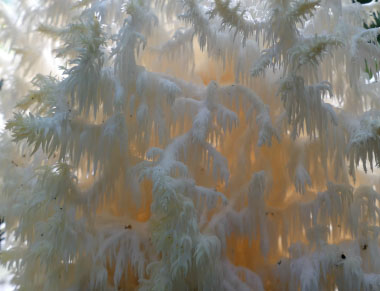
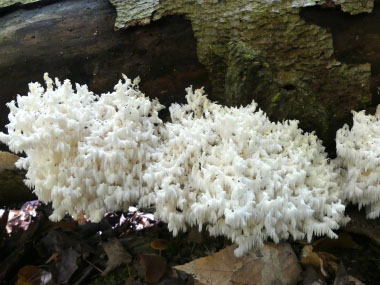
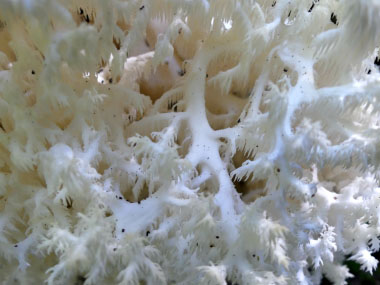
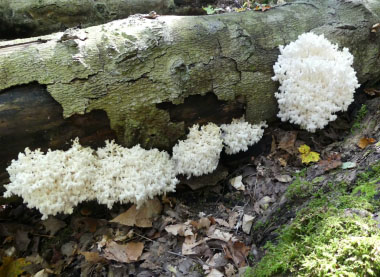
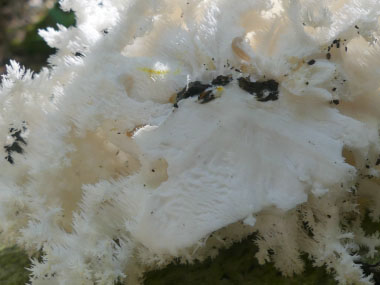
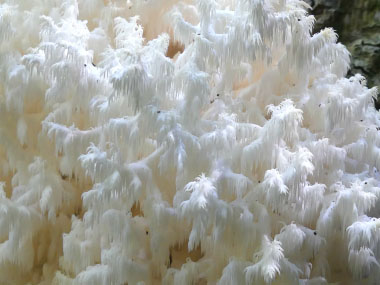

Do not eat any fungi that has not been properly identified by a qualified professional, some are DEADLY when ingested. All edible wild fungi MUST be cooked.
Hericium coralloides was formerly known as Hericium ramosum so this name may come up in online searches. It is saprobic and possibly somewhat parasitic. This delicately beautiful fungus typically fruits on fallen logs or branches of hardwoods. Often they can be spotted in large patches that can be seen from quite some distance. This fungus is often misidentified as being Hericium erinaceus or Hericium americanum. Hericium americanum is more branched than Hericium erinaceus and grows from the wood of living trees and dead hardwoods.
Type
Distinguishing Features
The comb tooth fungus is a large (mostly) white mass with an open framework of numerous toothed branches. This fungus typically grows between 10 and 40 cm wide; and anywhere from 5 to 20 cm high. The branches are coarse, toothy structures and occur on both sides of the branch somewhat like the teeth on a comb. These “teeth” (spines) are about 1 cm. The external appearance is white to creamy. The flesh is soft yet brittle. The stalk is an indistinct stub and is hairy.
Height
5 to 20 cm.
Habitat
This saprobic fungi fruits on dead hardwood or on living trees that have been injured; though it has been (supposedly) documented on conifers. It is solitary or clustered. Comb tooth fungus tends to fruit quite regularly on a tree but for few seasons (up to 5 years). The fruit bodies of Hericium coralloides usually signify a relatively advanced state of underlying decay.
Spore Print
White.
Season
Late August to late October. They can over winter and occur in spring in warmer climates; widely distributed throughout North America and Europe. This fungus also grows in India, Russia, China, and Japan.
Gills
Not applicable (toothed).
Edibility
Edible when young; be sure it is white. Mild nutty taste; cook before eating. To harvest the comb tooth, the best method is to cut the fruit body at the base, close to the wood and thus remove it in one piece; it is fragile and will break apart quite easily. Many wild picked Hericium fungi may house various tiny beetles. Thoroughly clean by shaking and hand removal if needed. If the mushroom has begun to discolour to a yellowish tone, it is old and likely will have a sour or unpleasant flavour after cooking.
Other Name
Coral Hedgehog.
Recipes
To support our efforts please browse our store (books with medicinal info, etc.).
Winter Survival Food Handbook

PDF Plant Magazines
Types of Wild Food
Geographic Zones Seasons
Disclaimer
EdibleWildFood.com is informational in nature. While we strive to be 100% accurate, it is solely up to the reader to ensure proper plant identification. Some wild plants are poisonous or can have serious adverse health effects.
We are not health professionals, medical doctors, nor are we nutritionists. It is up to the reader to verify nutritional information and health benefits with qualified professionals for all edible plants listed in this web site. Please click here for more information.
Why Edible Wild Food?
- Food costs are rising
- Free, wild food is readily abundant
- Wild food adds nutrition to your diet
- Wild food can help treat various medical conditions





